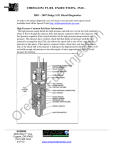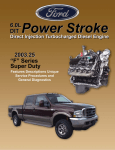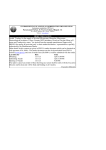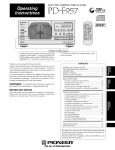Download 2001 – 2007 6.6L Diagnostics
Transcript
2001 – 2007 6.6L Duramax Diagnostics In order to do proper diagnostics you will need a scan tool and some special tools such as a vacuum test gauge J44638 (OTC 6754) available from GM Special Tools https://gmtoolsandequipment.com/ . Also note that 1 MPa (megapascal) is equal to approximately 145 PSI. O re g on Fu el I nj ec tio n High Pressure Common Rail Basic Information The high pressure pump builds rail pressure and delivers it to the fuel rail manifold where it flows through the injector lines to the injectors. The fuel pressure regulator in the high pressure pump controls rail pressure. The injectors have a hollow check ball that holds high pressure fuel until the fuel solenoid is actuated by the ECM, this allows the check ball to rise off its’ seat and an injection to take place. If the check ball in the injector is leaking due to erosion on the seat or the high pressure limit valve leaks then it will not build enough rail pressure to start the engine. It takes approximately 2500 PSI rail pressure to start. Oregon Fuel Injection 4036 W 1st Ave Eugene, OR 97402 541-485-1434 8/28/2015 www.oregonfuelinjection.com 1 CAUTION The fuel system contains high pressure fuel up to 25,000 PSI. Do not use you fingers to find fuel leaks! High pressure fuel entering your bloodstream may result in amputation or loss of life. ec tio n Preliminary checks 1. Check the oil level, LB7 engines have the injectors under the valve cover and are very susceptible to dilution. 2. Check and record any DTC, look at snap shot data or save, do not erase codes prior to doing repairs, you will erase the snapshot data. on Fu el I nj No Start or Hard Start 1. Excessive fuel restriction, check or change fuel filter 2. Use vacuum gauge, check the suction, you should have no more than 5 inches Hg at WOT (wide open throttle) or 7-8 inches Hg under load. If you have too much suction, after changing the filter, the restriction could also be the sock in the tank. Too little vacuum (less than 2 inches Hg) means that it could be sucking air. 3. Check for air in fuel system, install clears lines before and after the filter housing to check for air in the lines. 4. Confirm actual versus desired rail pressure, even under crank no start conditions 5. If the above are ok, then it comes down the following. a. fuel injectors (see injectors for more diagnostic information) b. high pressure injection pump c. Fuel pressure regulator, check to make sure it is not stuck. d. fuel pressure relief valve (high pressure limit valve), check to make sure it is not leaking into the return system when rail pressure is 160 MPa 6. Before condemning the high pressure pump you need to make sure there are no high pressure fuel leaks. Use the EN-47589 (same block-off caps as #9011 SPX Miller tools) cap set to cap off the injector rail to isolate the injectors from the injector return system. O re g Black Smoke 1. If at idle, use the scan tool to cut out one cylinder at a time and see if the smoke disappears. 2. Dirty air filter 3. Exhaust leaks or Boost leaks, you can usually hear a boost leak as a high pitched squeal under load. 4. EGR and or MAF problems or intake leaks after the MAF sensor. Misses 1. Use scan tool to isolate one cylinder at a time. Run the injector balance test, running the test hot (after a hard drive) and in drive will give the most consistent results. 2. A missing or damaged chamber gasket or low compression could cause a miss. Oregon Fuel Injection 4036 W 1st Ave Eugene, OR 97402 541-485-1434 8/28/2015 www.oregonfuelinjection.com 2 3. Crankcase overfull (fuel dilution) can cause a rough run and balance rates out of specification. ec tio n Knock 1. Use scan tool to isolate one cylinder at a time. 2. Use cap off tool EN-47589 to block off one injector at a time. 3. A slight knock can start occurring due to injector problems, often after a contaminated fuel problem. Surge or Lope at idle 1. Fuel pressure regulator: Map actual versus desired rail pressure, if the graph is wavy and there is no air in the system it is usually caused by a bad fuel pressure regulator. 2. Air in the fuel system (see fuel supply and filter housing section) re g on Fu el I nj White or Blue smoke at idle when cold If the smoke clears in less than 1 minute, this would be normal depending on temperature and altitude. Blue white smoke that burns your eyes is un-burnt fuel; cold temperatures, high altitude and excessive idle time all mean cold combustion and white smoke. 1. Possible bad injector, use the scan tool to cancel one cylinder at a time and see if the smoke clears up. However, using the scan tool to kill the injector does not reduce rail pressure in the injector and the tip can still leak fuel, cap off lines one at a time (cap is tool # EN-47589) to pinpoint injector. Also look at the balance rates, if the tip is leaking fuel then the balance rates may be out of specification. Try increasing the rail pressure, we find injector nozzles that leak at idle pressure, but do not leak at higher pressure. 2. Check glow plug operation when cold. 3. Check rail pressure when engine is off, it should 1.0-1.8 MPa, depending on the engine model. 4. Excessive idle time can cause white smoke when cold due to carbon build up on injector tips. More than 20% idle time is excessive. If the injectors have excessive carbon on the nozzle tip then balance rates should be high on that cylinder. O Dilution 1. Cracked injector 2. Injector return lines are under the valve cover on LB7 engines. Pressurize the return circuit with the valve covers off and look for bubbles or vacuum test the return circuit off of each head, the return should hold 15 inches Hg of vacuum. Oregon Fuel Injection 4036 W 1st Ave Eugene, OR 97402 541-485-1434 8/28/2015 www.oregonfuelinjection.com 3 ec tio n 3. On the LB7 dilution problems that occur after you have replaced the injectors could be return line leaks under the valve cover or leaks at the injector line to injector connection. 4. We highly recommend vacuum testing the injector returns after replacing the injectors and before installing the valve covers to be sure there is no leaks. This can save a lot of labor in the long run and customer down time. 5. The green coated injector lines are more susceptible to leaks versus the polished steel colored lines. 6. Leak at the high pressure pump drive shaft seal. 7. You can also use a dye in the fuel and black light kit to try to pinpoint leaks at the injectors on an LB7. Follow the “fuel leaks inside of engine” GM service information. re g on Fu el I nj Fuel Supply and Fuel Filter Housing The fuel filter housing is on the suction side (there is not a supply pump from the factory) and are prone to suck air. Follow the GM fuel system diagnosis in the service manual. 1. Install fuel vacuum test tool. 2. Prime the fuel system with the hand primer until 10 PSI is indicated on the gauge, check for external leaks and repair. If the pressure drops from 10 PSI to 2 PSI in less than 1 minute, remove the fuel outlet line from the filter and cap it. Remove the ignition 1 relay and crank the engine for 2 - 15 second intervals, the high pressure pump should pull at least 12 inches of Hg vacuum. If air gets into the system it will cause a false/low reading. 3. Install clear hoses at the inlet and outlet of the fuel filter housing. Re-prime the system and then start the engine, there should be very little air going into or coming out of the fuel filter housing. 4. Common air ingestion places are the filter housing, plugged filter, drain valve, rubber hoses and connections. You need to use clear lines to isolate where the air is coming from and work your way back toward the tank until you don’t have any more air coming through the clear line. Unless you know where to get the tool that sees through black rubber lines to find air, your only other option is to bounce around and replace parts. O High Pressure Injection Pump (CP3 Pump) 1. Before condemning the pump for a starting issue you need to be certain that the high pressure fuel system is not leaking the pressure. Perform the injector return flow test. 2. If there has been a major contamination issue with dirt and or water then it is very likely that the high pressure pump will need to be replaced. However, the injectors are typically damaged first, but any contamination that got into the injectors went through the CP3 pump first. Oregon Fuel Injection 4036 W 1st Ave Eugene, OR 97402 541-485-1434 8/28/2015 www.oregonfuelinjection.com 4 ec tio n 3. The most common failure of the high pressure pump is the inability to keep up with high fuel demand such as towing a trailer up a hill. This problem will usually set a low rail pressure code. 4. Other Notes: If the vehicle has starting issues then the injectors are the most likely cause. Perform the injector return flow test. If the vehicle only acts up during a hard pull with a load and there are no restriction issues then it is more likely a HP pump causing the problem. A limit valve could also cause this problem. O re g on Fu el I nj Injectors It takes about 2500 PSI rail pressure for the injectors to deliver fuel and the engine to start. 1. Injector return flow; maximum allowable leakage for one injector is 5 ml in 15 seconds, maximum per bank is 20 ml: check when cranking, with the FICM disabled, pressure should be 114 – 135 MPa during cranking. Specifications are for API rating of 40-44. 2. GM only provides a specification for return fuel when cranking for LB7 engines, however, we have done some testing on a good running LB7 and found that injector return flow at idle from one bank was 95 – 110 ml in one minute at 21,000 PSI. 3. Excessive leakage from the injectors usually results in a starting issue, which could occur hot or cold, but usually occurs hot because the fuel is thinner when hot. However, excessive leakage from the injectors can also cause a DTC P0087, P0093 or a P1093 to set. When using the scan tool to increase rail pressure at idle, if you can’t get to 21,000 PSI then the injectors are usually bad. 4. You can also use balance rates to help determine if you have any bad injectors. If an injector is leaking excessively into the return the balance rates are often at the edge of specification. Injectors that have a poor cylinder power contribution or a noise or smoke change when canceled will also need to be replaced and are likely to cause low rail pressure during cranking. 5. LBZ Enhanced Injector Return Flow Test- GM has come up with a test for use on the later Duramax engines. This test is specifically for the LBZ engine, but could be applied to LLY and LMM engines also. The test steps are listed belowA. Engine at normal operating temperature, 181-189 deg. F. B. Remove return hoses from one bank of injectors. C. Use adapters to run hoses off of injector returns in to individual graduated containers. D. Run engine until fuel flows from all four injector return hoses. Then with the engine at idle, command rail pressure to 17,400 psi with the scan tool. Place the hoses in the graduated containers for 30 seconds. E. Turn off ignition and record measurements. F. Repeat above steps on the other bank of injectors. G. Add up all recorded measurements to determine total injector return volume. If the return volume is less than 144 ml for all 8 injectors, refer to the high pressure pump test. If the return volume is greater than 72 ml per bank, replace any individual injector with return volume greater than 18 ml. Oregon Fuel Injection 4036 W 1st Ave Eugene, OR 97402 541-485-1434 8/28/2015 www.oregonfuelinjection.com 5 ec tio n 6. Other Injector Notes Balance Rates, when checked hot in drive after a hard test drive, should indicate bad injectors. Any injectors that are more than +/- 6 are a possible cause for rough run. Miss, smoke or rough run usually indicate that the injectors are the cause. LMM engines with a DPF may not show any smoke, but frequent DPF regen events would suggest poor combustion. We have seen a couple of vehicles with no starting issues, but injector return is excessive at higher rail pressures, this can cause a P0093 or P1093. nj Turbo 1. 2001-2006; turbo bearing failure may be caused by a spun camshaft bearing. Inspect for a spun number 4 camshaft bearing, refer to TSB 03-06-93-001B. 2. 2004.5 and newer turbos have a vane position sensor, check actual versus desired. 3. Vane position sensor codes a lot of times indicate sticky or stuck vanes, or unison ring wear. The design of these turbos is nearly identical to 6.0l Powerstroke turbos which are known for this type of failure. The turbos may free up at higher rpm due in part to additional oil pressure/volume to drive the vane actuator. DTC Codes Fu el I Use the following information regarding diagnostic trouble codes in addition to the normal diagnostic procedures outlined in the service manual or technical service bulletins. O re g on P0087; fuel rail pressure is less than 22.5 MPa at more than 600 RPM, fuel rail pressure too low. For LLY, LBZ, LMM, see Enhanced Injector Return Flow Test above also. 1. Excessive restriction, fuel supply, plugged filter or sucking air. Install special tool J44638 to check vacuum restriction on fuel supply to the high pressure pump. Maximum restriction at WOT (wide open throttle) is 5 inches HG in park. When driving under hard acceleration maximum would be 7-8 inches Hg. If too high replace the fuel filter and retest. 2. If restriction is only a couple of inches vacuum, that could indicate that the fuel supply system is sucking air, use clear fuel lines at the filter head to check for air. 3. Excessive restriction could also cause a DTC P1093 to set at the same time. 4. Rail pressure should read 1-1.8 MPa with key on and engine off. If out of range replace the rail pressure sensor. 5. Check fuel return from the high pressure limit valve or fuel pressure relief valve. If it is leaking then it will need to be replaced. We have also heard of race plugs leaking, even if you have a race plug, you may want to check for leakage at max rail pressure. 6. With the engine up to operating temperature, use the scan tool to command rail pressure to 21,000 PSI, if the rail pressure will not achieve 21,000 PSI at idle you most likely have a problem with the injectors, Especially if you are having a hard start, miss, rough run or smoke and balance rates are excessive. Perform the enhanced injector return test. Oregon Fuel Injection 4036 W 1st Ave Eugene, OR 97402 541-485-1434 8/28/2015 www.oregonfuelinjection.com 6 7. Disconnect the fuel rail pressure sensor the fuel pressure should be greater than 175 MPa as displayed on the scan tool. 8. If these codes set only on hard acceleration or when pulling a hill with a load, check fuel supply issues first. Then see if rail pressure will reach 21,000 PSI at idle, if it does then the low rail pressure under a heavy load is usually caused by a bad high pressure pump. nj ec tio n P0089; The engine control module (ECM) uses commanded fuel pump flow to determine a desired fuel rail pressure (FRP). The actual fuel pressure is monitored using the FRP sensor. If the FRP sensor indicates a pressure more than 20 MPa greater than desired, DTC P0089 will set. 1. Open or poor connections at the MPROP connector/pigtail or main engine harness connector will cause loss of pressure control, maximum rail pressure at idle. 2. A stuck MPROP can cause excessive rail pressure. 3. Bad suction valves in the high pressure pump can cause rail pressure to be excessive. 4. The ECM can fail and cause the rail pressure to increase beyond the desired amount. Fu el I P0093 on 2001 (P1093 on later vehicles); Difference between commanded fuel pressure and actual pressure is greater than 20 MPa. If P0087 is set solve P0087 first Similar diagnostics to DTC P0087 P0201 – P0208 misfire codes 1. Can be caused by the FICM wire harness rubbing on the back of the alternator, alternator bracket or FICM harness retaining bracket. 2. Air in the fuel system can also cause misfire codes. re g on P1093 Large Leak; difference between commanded fuel pressure and actual pressure is greater than 20 Mpa. Large leak means there is a leak in the high pressure system. Large leaks go into the return system and flow back to the tank, these are not external leaks. 1. If P0087 is set, solve P0087 first. 2. Similar Diagnostics to P0087 O P2146 or 2149; cylinder bank shut down 1. Can be caused by the FICM wire harness rubbing on the back of the alternator, alternator bracket or FICM harness retaining bracket. 2. LLY engine (2004.5-2005), #2 (P0202) and #7 (P0207) misfire codes set with codes P2146 and P2149. Refer to TSB 05-06-04-047B to repair the injector harness brackets and connectors (part # 98017958) for #2 and #7 before replacing the FICM or the injectors. Oregon Fuel Injection 4036 W 1st Ave Eugene, OR 97402 541-485-1434 8/28/2015 www.oregonfuelinjection.com 7 Other Useful Tips O re g on Fu el I nj Medium Duty GM trucks (C4500+) may have a rear axle steer switch located in the center of the dash. If this switch is turned on, the engine will have low power, low boost, and low rail pressure readings. This switch will also be in trucks without rear steer! Chassis Cab and Medium Duty trucks with a PTO will exhibit the same symptoms as listed above if the switch is on. Injector commanded pulse width can be used to determine injector/cylinder issues. As a general rule, anything under .30 ms at idle in gear will indicate an over fueling injector. Anything over .50 will indicate an under fueling injector or weak cylinder. Firing Order 1-2-7-8-4-5-6-3 ec tio n Oregon Fuel Injection 4036 W 1st Ave Eugene, OR 97402 541-485-1434 8/28/2015 www.oregonfuelinjection.com 8

















